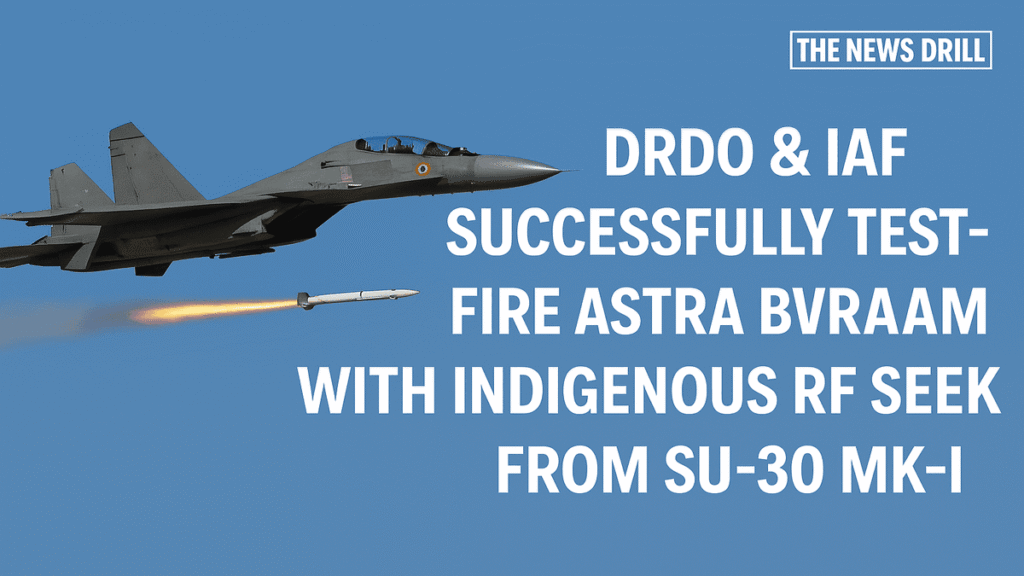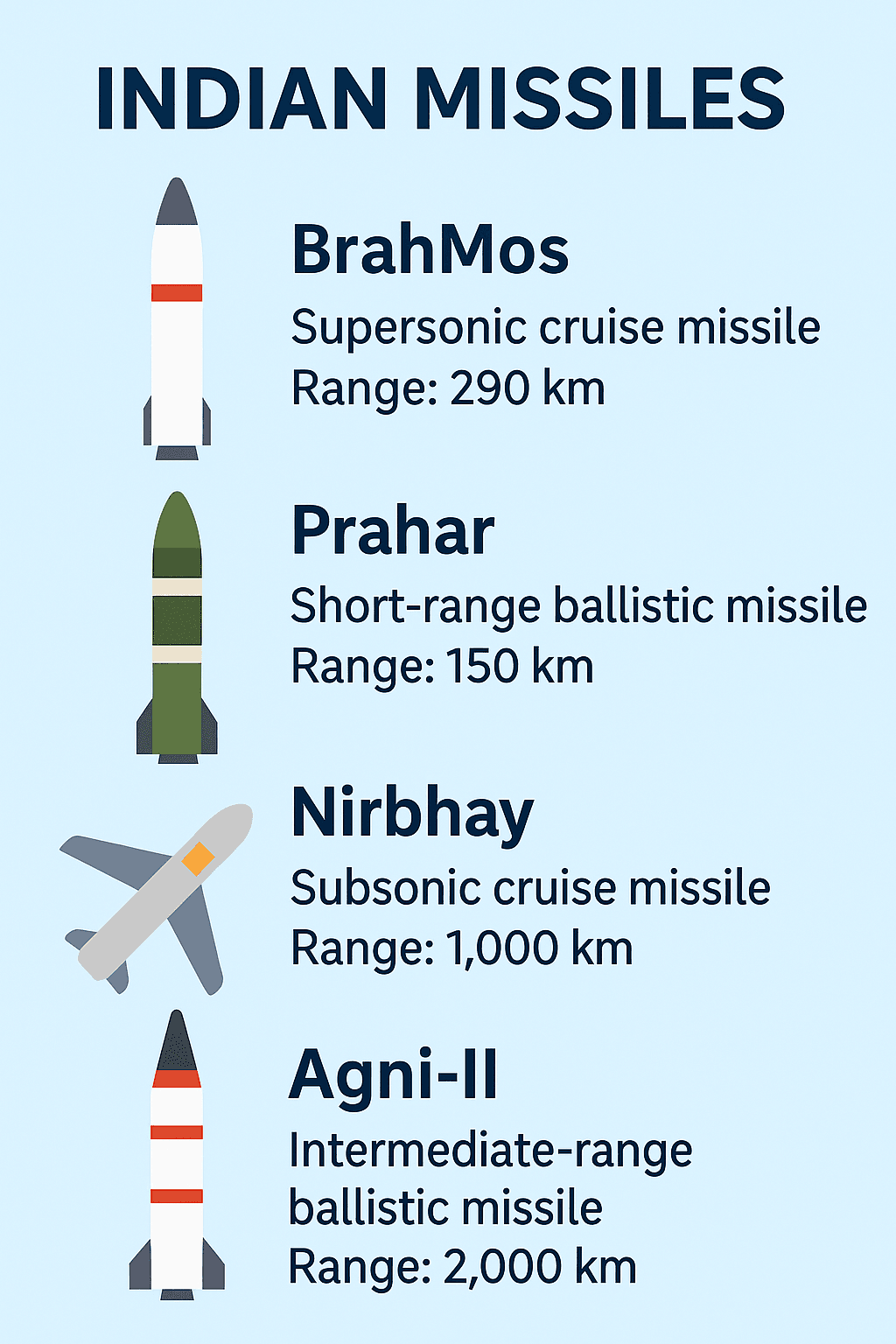
DRDO & IAF Successfully Test-Fire Astra BVRAAM with Indigenous RF Seeker from Su-30 Mk-I
New Delhi, India — July 12, 2025: In a significant boost to India’s indigenous defence capabilities, the Defence Research and Development Organisation (DRDO) in collaboration with the Indian Air Force (IAF) has successfully conducted the flight-test of the Astra Beyond Visual Range Air to Air Missile (BVRAAM) with an indigenous Radio Frequency (RF) seeker from a Su-30 Mk-I aircraft.
- DRDO & IAF Successfully Test-Fire Astra BVRAAM with Indigenous RF Seeker from Su-30 Mk-I
- Astra BVRAAM: India’s Answer to Future Air Combat
- Highlights of the Test Firing
- Indigenous RF Seeker: A Breakthrough in Missile Guidance
- Technical Specifications of Astra BVRAAM
- Astra BVRAAM’s Role in India’s Defence Strategy
- Comments from Defence Officials
- Future Plans for Astra BVRAAM Deployment
- Comparison with Global Counterparts
- Boost to Aatmanirbhar Bharat
- Conclusion
The test, which included two crucial launches against high speed unmanned aerial targets at varied ranges and conditions, demonstrated the pin point accuracy and reliability of the Astra BVRAAM, reaffirming India’s advancement in air combat systems.
Astra BVRAAM: India’s Answer to Future Air Combat
The Astra BVRAAM is India’s first indigenous Beyond Visual Range Air to Air Missile, developed by DRDO with the aim of eliminating enemy aircraft at ranges exceeding 100 kilometers. This highly sophisticated missile is designed to be launched from fighter aircraft to engage aerial targets beyond the pilot’s line of sight.
The recent tests mark a milestone as the Astra BVRAAM was equipped with an indigenous RF seeker, a key component that enhances its target locking capabilities even under jamming and evasive conditions.
Highlights of the Test Firing
- Date of Test: July 12, 2025
- Launch Platform: Su-30 Mk-I fighter aircraft
- Missile Tested: Astra BVRAAM with indigenous Radio Frequency Seeker
- Target: High-speed unmanned aerial targets
- Outcome: 100% accuracy in both test launches
According to an official statement by the Ministry of Defence, “Two successful launches were conducted to evaluate the missile’s capability in different engagement scenarios, including varying ranges, target aspects, and environmental conditions. In both cases, the Astra BVRAAM achieved a direct hit on the target.”
Indigenous RF Seeker: A Breakthrough in Missile Guidance
One of the most remarkable aspects of this test is the incorporation of the indigenous RF seeker, which has been developed by DRDO laboratories within India. This seeker technology is critical to a missile’s terminal phase performance allowing it to detect, track, and lock onto the target with precision.
The integration of this indigenous component is a game-changer, making the Astra BVRAAM not only more reliable but also free from import dependencies, aligning with India’s Aatmanirbhar Bharat initiative in defence manufacturing.
Technical Specifications of Astra BVRAAM
| Feature | Specification |
|---|---|
| Range | Over 100 km |
| Speed | ~Mach 4.5 |
| Seeker | Indigenous RF seeker |
| Platform | Su-30 Mk-I, Tejas, Mirage 2000 (planned) |
| Warhead | High-explosive fragmentation |
| Guidance | Inertial + mid-course update + terminal active radar homing |
The Astra BVRAAM stands out for its advanced mid course guidance system, active radar homing, and high maneuverability. These features allow it to effectively engage and destroy high speed, maneuvering targets in air combat scenarios.
Astra BVRAAM’s Role in India’s Defence Strategy
In the current geopolitical environment, maintaining air superiority is essential for national security. The deployment of Astra BVRAAM empowers the Indian Air Force with a homegrown, cost effective, and battle ready air to air missile that can match or exceed the performance of similar systems like the American AIM-120 AMRAAM or the Russian R-77.
By reducing reliance on foreign technology and suppliers, Astra BVRAAM enhances strategic autonomy and ensures logistical independence during wartime.
Comments from Defence Officials
Defence Minister Rajnath Singh lauded the successful test on social media platform X, stating:
Congratulations to @DRDO_India and the Indian Air Force on the successful flight-test of the Astra BVRAAM with an indigenous seeker. This marks a significant step in our efforts to enhance self-reliance in defence technologies. Jai Hind!”
A senior IAF official added:
“The precision of the Astra BVRAAM in these tests proves its operational readiness. The indigenous RF seeker is a technological milestone. We are confident of deploying this system soon.”
Future Plans for Astra BVRAAM Deployment
Following the successful validation of its indigenous RF seeker and multiple test firings, the Astra BVRAAM is now set for mass production and integration with various Indian fighter platforms.
The IAF plans to integrate the Astra system not only on Su-30 Mk-I aircraft but also on the HAL Tejas Mk1A, Mirage 2000, and eventually on the Rafale and AMCA (Advanced Medium Combat Aircraft) platforms.
This broad integration ensures that Astra BVRAAM will become a mainstay of India’s aerial combat doctrine.
Comparison with Global Counterparts
| Missile | Country | Range | Guidance | Equivalent to Astra? |
|---|---|---|---|---|
| AIM-120 AMRAAM | USA | 105 km | Active Radar | Yes |
| R-77 | Russia | 80–100 km | Active Radar | Yes |
| Meteor | Europe | 150+ km | Ramjet + Active Radar | No, Meteor has longer range |
| Astra BVRAAM | India | 100+ km | Indigenous RF Seeker | Competitive |
While the Meteor missile from Europe has a longer range, the Astra BVRAAM is cost effective, locally produced, and offers equivalent reliability and flexibility for most combat scenarios faced by India.
Boost to Aatmanirbhar Bharat
The development and success of the Astra BVRAAM is a shining example of India’s indigenous defence capabilities. Under the leadership of DRDO and in alignment with the Aatmanirbhar Bharat initiative, the missile’s success highlights India’s ability to innovate independently in critical defence technologies.
The successful integration of the indigenous RF seeker has not only reduced reliance on foreign suppliers but also opened avenues for exporting this technology to friendly nations in the future.
Conclusion
The recent test-firing of the Astra BVRAAM from a Su-30 Mk-I fighter jet represents a landmark achievement in India’s journey toward self reliance in defence manufacturing. The missile, with its over 100 km range, indigenous RF seeker, and state of the art guidance, is poised to become the backbone of India’s air to air combat capabilities.
As more successful trials follow and as the missile enters active service, Astra BVRAAM will significantly enhance the Indian Air Force’s operational readiness, reduce foreign dependency, and position India as a rising defence exporter in the global arena.
Stay Connected for more updates on India’s indigenous defence technologies and breakthroughs in air combat system.
Contact us: contact@thenewsdrill.com
Submit tips or defence related stories: editor@thenewsdrill.com
Visit www.thenewsdrill.com for detailed analysis, military reports, and national defence news.

















